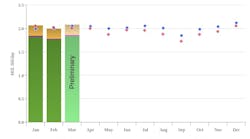Sam Fletcher
OGJ Online
HOUSTON, Nov. 13 -- Shell Exploration & Production Co. is developing new technologies, systems, and products that can be used in various combinations to reduce drilling costs, company officials said Tuesday at a press briefing in Houston.
"We're going down several roads with this," said Don Jacobsen, manager of drilling and completions for the company in New Orleans.
"Well costs in deep water are driven primarily by daily rig rates and the time spent drilling the well," said Paul Goodfellow, drilling and completions operations manger for Shell International Exploration & Production Inc. Using technology to drill a well faster with a smaller, cheaper rig reduces those costs, he said.
Shell is developing a surface blowout preventer for use on a floating rig to drill geopressurized wells in the Gulf of Mexico. Such a system currently is being used only in normally pressured environments in the Far East, said company officials.
Depending on project scope and feasibility, use of a surface BOP can reduce conventional well costs by 20%-50%. "That's why we're taking this so seriously," said Graham Brander, senior drilling engineer for Shell International Exploration & Production Inc.
With the BOP at the surface, a smaller casing and riser system is necessary, which means the company can use smaller third generation semisubmersible rigs, with much lower day rates than the fifth generation units usually used.
That potentially increases the number of rigs available for deepwater projects and the number of projects per rig sequence.
Shell engineers are developing a laterally unconstrained surface BOP for technically challenging, low drilling-margin wells in the Gulf of Mexico. Unlike other surface BOP systems, Brander said, the Shell system can be transferred from one rig to another as needed. It features a subsea shut off and disconnect device.
Shell also is using its expandable tubular technology to drill low-margin ultradeepwater wells in the gulf.
"We see this down the road as an enabling technology to allow a step change in well design with the use of smaller rigs and smaller drilling risers and BOP systems, which will lower well costs," said Ken Dupal, senior staff drilling engineer with Shell Exploration & Drilling Co.
He said the next step that Shell engineers will be working to develop in 2002 is a monodiameter well design, with one size of pipe that is run continuously and that can be drilled with a coiled-tubing system.
That, said Shell engineers, will further increase the number of wells that can be drilled with a compact rig.
Shell also has developed a taut mooring system using suction anchors and synthetic lines that is lighter than conventional steel wire and chain mooring systems. The resulting weight reduction also extends the operating parameters for smaller rigs into deeper waters. Shell's system also uses a single boat for installation of the mooring system before the rig move on site, further reducing time and costs.
The company also developed special formation-strengthening fluids and technology to drill through severely depleted zones that otherwise would cause the wellbore to collapse. Workers using that technology recently drilled the Ursa A-11 well through a 6,000 psi depleted sand without affecting the 30,000 b/d production of the nearby Ursa A-6 horizontal well, Jacobsen said.
Contact Sam Fletcher at [email protected]
